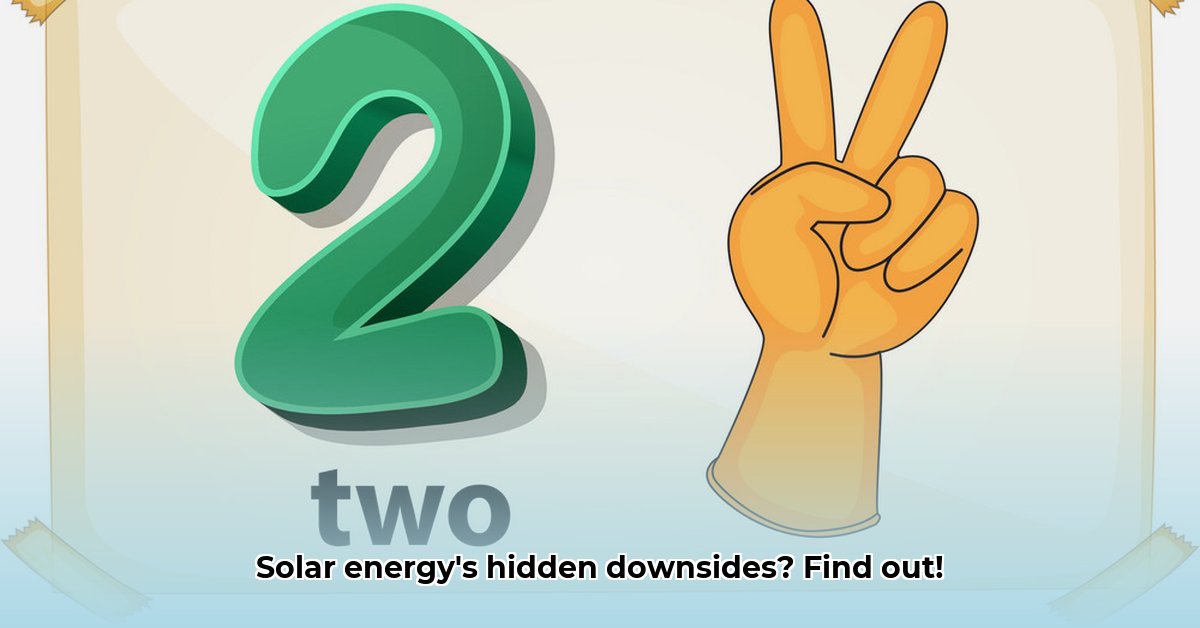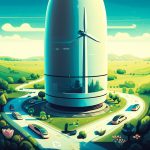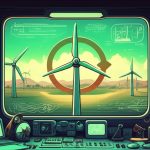Going solar sounds great – clean energy, lower bills, right? But like anything, it’s not perfect. Two big things people sometimes miss are that the sun doesn’t always shine (meaning your solar panels don’t always work), and there’s a whole issue of what to do with those panels when they’re worn out. This article takes a closer look at these downsides, explaining them simply so you can make informed decisions about solar energy, whether you’re a homeowner thinking about installing panels, a policymaker shaping energy plans, or just curious about the realities of clean energy.
Exploring the Two Primary Drawbacks of Solar Energy
Let’s talk solar power. It’s an increasingly popular and environmentally friendly energy solution, but it’s not without its challenges. We’ll explore two significant hurdles that keep solar energy from being a flawless alternative to traditional energy sources. Are you fully aware of the drawbacks involved when switching to solar energy? These commonly overlooked factors could influence your decision-making process.
The Sun’s Schedule: Intermittency’s Impact on Solar Power Generation
One major challenge is that the sun, well, isn’t always shining. Unlike a power plant that operates continuously, solar panels only produce electricity when the sun’s out. That means your power production takes a major dive at night and on cloudy days. This inconsistency makes things tricky for maintaining a reliable power grid. Power grids need a consistent supply of electricity, and solar’s fluctuating output can cause instability.
To solve this, we need effective ways to store the extra solar energy generated during sunny periods. Battery storage is a popular option, but it can be expensive and may not hold enough power for extended periods of darkness or cloudy weather. Other backup energy sources, such as natural gas power plants, could be used, but that reduces the environmental benefits of going green. This reliance on backup systems also means a more complex and potentially costly energy infrastructure.
The unreliability of solar energy is a factor that needs to be accounted for to make solar power truly viable. Researchers are constantly working on better battery technologies and smarter ways to integrate solar power into the grid to smooth out these fluctuations. Investments in grid modernization can enable a more stable renewable energy infrastructure.
Land Usage and Life Cycle Environmental Concerns
While solar energy is much cleaner than fossil fuels during operation, it’s not entirely without an environmental footprint. To generate substantial quantities of solar energy, we need large areas of land for solar farms. These vast arrays of panels can compete with farmland, natural habitats, and other important land uses. Finding suitable locations for large-scale solar projects is a real balancing act between energy needs and environmental preservation.
Furthermore, the manufacturing of solar panels uses various materials, some of which are toxic. And, eventually, those panels wear out. We need efficient and environmentally sound methods for recycling these panels, and such systems are still in their early stages of development. This challenge necessitates careful consideration of the entire life cycle of a solar panel – from its creation to its eventual disposal – to minimize any negative impacts. Advanced material sciences may hold the key to unlocking safer and more sustainable solar panel production.
There’s also ongoing research into whether the habitat disruption caused by solar farms outweighs the benefits of cleaner energy generation. Certain species might be more negatively impacted than others, and these impacts can vary depending on the location and type of solar farm. It’s a complex issue with many nuances. Innovative designs for solar farms could actively support local ecosystems and biodiversity.
Table: Weighing the Pros and Cons of Solar Energy
| Feature | Advantages | Disadvantages |
|---|---|---|
| Electricity Generation | Clean, renewable energy source; reduces carbon emissions | Intermittent power production; dependent on weather conditions |
| Environmental Impact | Reduces reliance on fossil fuels; lower greenhouse gas emissions | Requires significant land use; manufacturing and disposal concerns |
Addressing the Challenges: A Path Forward for Sustainable Solar Solutions
The challenges of intermittency and land use aren’t insurmountable roadblocks. Scientists and engineers are constantly working on better batteries, smarter grids that can manage fluctuating energy supplies, and more efficient solar panel designs. There are also ongoing efforts in developing enhanced recycling processes for solar panels that minimize environmental risks. Furthermore, careful planning and regulations can help to minimize the environmental impact of solar farms, ensuring they are sited strategically and with minimal disruption to ecosystems. It’s a collaborative effort that involves technological innovation, smart policy decisions, and a careful consideration of both the positive and negative aspects of solar energy. The future of solar power is bright, and understanding its limitations is key to harnessing its full potential responsibly. Artificial intelligence may play a crucial role in optimizing energy grids to better handle renewable sources as adoption increases.
How to Mitigate Solar Panel Intermittency Challenges with Battery Storage Solutions: A Comprehensive Guide
Key Takeaways:
- Solar power’s intermittency, its biggest weakness, is its inconsistent energy output due to weather changes.
- Battery storage systems effectively address this issue by storing excess solar energy for later use.
- Lithium-ion batteries currently dominate the market, but emerging technologies present promising alternatives.
The Sun’s Fickle Nature: Understanding Solar Intermittency Factors
The sun doesn’t shine constantly; clouds, nightfall, and seasonal changes all affect solar energy production. This inconsistency, known as intermittency, is a major hurdle for solar power’s wider adoption. It can be envisioned as a river with a fluctuating flow—sometimes a torrent, sometimes a trickle. That’s solar energy without a reliable buffer. This unpredictability makes it difficult to consistently power homes and businesses, and poses significant challenges for integrating solar energy into the broader electrical grid. Enhanced predictive models could anticipate solar power generation to improve grid stability.
Harnessing the Power of Storage and Grid Integration Technologies
Mitigating solar panel intermittency challenges with battery storage solutions is essential. Batteries act as reservoirs for solar energy. They store excess energy generated during sunny periods and release it when needed, smoothing out the supply and ensuring a more stable and reliable energy flow. The system works effectively, providing power when the sun isn’t shining. Innovative storage solutions beyond conventional batteries are constantly being explored.
Current Technologies: Lithium-ion and Beyond Battery Chemistry
Lithium-ion batteries currently dominate the energy storage market. They’re relatively efficient, have a high energy density, and costs are decreasing. However, these batteries have limitations including finite lifespans and environmental concerns related to their manufacturing and disposal.
Emerging technologies like flow batteries offer exciting possibilities. While currently more expensive, they offer longer lifespans and greater storage capacity, making them potentially more suitable for large-scale grid applications; they are similar to a larger, more durable energy reservoir. The long-term environmental impacts of different battery technologies require ongoing evaluation.
Two Key Overlooked Drawbacks of Solar Energy and Energy Storage
-
The Intermittency Issue: As we’ve discussed, the sun’s unpredictable nature directly impacts power generation. While battery storage helps, it doesn’t entirely eliminate the problem, especially on a larger scale. Powering a city solely with solar panels during a week of overcast skies would require significant energy reserves. Determining the true cost of ensuring 100% renewable energy reliability is a critical question.
-
Storage Capacity and Costs: Storing enough energy to meet demand, particularly during periods of low solar irradiance, such as long winter nights, demands substantial storage capacity. Building and maintaining such systems involves significant upfront costs, creating a significant barrier to widespread adoption and highlighting a challenge in discussing large-scale solar implementations. Creative financing models are needed to accelerate the deployment of large-scale energy storage.
Navigating the Future of Solar Energy: Policy and Technological Advancements
Overcoming these drawbacks requires a multi-faceted approach. Research and development of more efficient and cost-effective battery technologies are crucial. Improvements to grid infrastructure are also needed to better integrate diverse energy sources, including solar and wind power. Smart grids can help facilitate this, optimizing energy distribution and minimizing waste.
Government policies, such as subsidies and carbon pricing mechanisms, also play a vital role. These incentives can reduce costs, making solar energy and its associated storage systems more economically viable. The future of clean energy depends on strong collaboration between innovators, policymakers, and the public.
Solar Panel Intermittency And Its Impacts: A Comparative Study Exploring the Challenges
Solar power, while a fantastic green energy source, isn’t perfect. We often hear about its advantages – clean energy, reduced carbon footprint – but what about the downsides? We’ll dive into two major drawbacks that often get sidelined in the excitement: intermittency and its ripple effects. A balanced conversation is critical when discussing the real costs and benefits of solar power.
The Unpredictable Sun: Understanding Intermittency and its Correlation to Energy Output
Solar power’s biggest
- Wind Turbine Generator Kit For Home: Is One Right For You? - November 2, 2025
- Wind Turbine Fire: Questions About Safety Spark Debate - October 31, 2025
- Vertical Axis Wind Turbine Design: Improving Efficiency and Overcoming Limits - October 29, 2025
















